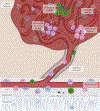Skull bone marrow channels as immune gateways to the central nervous system
- PMID: 37996526
- PMCID: PMC10894464
- DOI: 10.1038/s41593-023-01487-1
Skull bone marrow channels as immune gateways to the central nervous system
Abstract
Decades of research have characterized diverse immune cells surveilling the CNS. More recently, the discovery of osseous channels (so-called 'skull channels') connecting the meninges with the skull and vertebral bone marrow has revealed a new layer of complexity in our understanding of neuroimmune interactions. Here we discuss our current understanding of skull and vertebral bone marrow anatomy, its contribution of leukocytes to the meninges, and its surveillance of the CNS. We explore the role of this hematopoietic output on CNS health, focusing on the supply of immune cells during health and disease.
© 2023. Springer Nature America, Inc.
Conflict of interest statement
Competing interests
J.K. is a scientific advisor for Sana Biotechnology. M.N. has received funds or material research support from Alnylam, Biotronik, CSL Behring, GlycoMimetics, GSK, Medtronic, Novartis and Pfizer, as well as consulting fees from Biogen, Gimv, IFM Therapeutics, Molecular Imaging, Sigilon, Verseau Therapeutics and Bitterroot. The other authors declare no competing interests.
Figures



References
-
- Steinman L. Blocking adhesion molecules as therapy for multiple sclerosis: natalizumab. Nat Rev Drug Discov 4, 510–518 (2005). - PubMed
-
- Mrdjen D. et al. High-Dimensional Single-Cell Mapping of Central Nervous System Immune Cells Reveals Distinct Myeloid Subsets in Health, Aging, and Disease. Immunity 48, 380–395.e6 (2018). - PubMed
-
- Hove HV et al. A single-cell atlas of mouse brain macrophages reveals unique transcriptional identities shaped by ontogeny and tissue environment. Nat Neurosci 22, 1021–1035 (2019). - PubMed
Publication types
MeSH terms
Grants and funding
LinkOut - more resources
Full Text Sources

